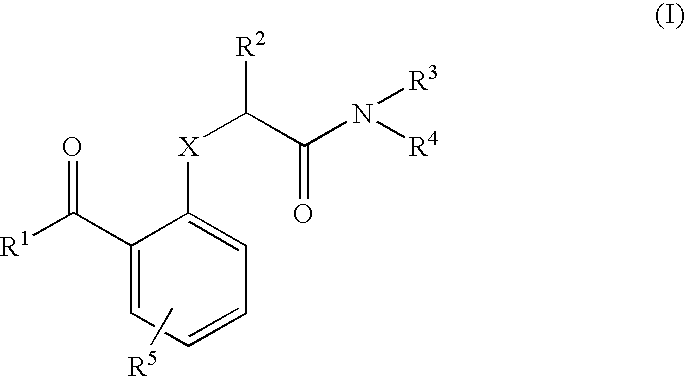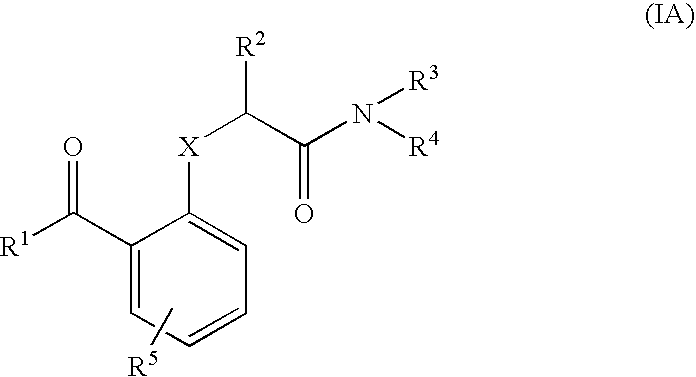Benzophenones as inhibitors of reverse transcriptase
a reverse transcriptase and benzophenone technology, applied in the direction of anti-infective drugs, amide active ingredients, drug compositions, etc., can solve the problem of reducing the sensitivity to other reverse transcriptas
- Summary
- Abstract
- Description
- Claims
- Application Information
AI Technical Summary
Benefits of technology
Problems solved by technology
Method used
Image
Examples
example 1
[0425]
Step A:
[0426]
[0427]A solution of 2-Bromo-4-Chloroanisole (8.98 g, 40.54 mmol) in diethyl ether (65 mL) was cooled to −78° C. and n-butyl lithium (26 mL of a 1.6 M solution in hexanes, 41.6 mmol) was added from a syringe. The resulting orange solution was allowed to stir at −78° C. for 30 min, after which time 2-thiazolecarboxaldehyde (4.53 g, 40.04 mmol) was added neat, resulting in a purple solution. The mixture was allowed to stir at −78° C. for 15 min, after which time water (50 mL) was added and the mixture was allowed to warm to RT. The mixture was poured into a separatory funnel containing ether and water. The organic layer was collected and was washed with water, brine, dried over MgSO4, filtered and the solvents were removed under reduced pressure to afford a white solid. The solid was washed with hexanes and was dried in vacuo; affording white needles (5.21 g, 51$). 1H NMR (CDCl3, 400 MHz) δ 7.70 (d, J=4 Hz, 1H), 7.38 (d, J=4 Hz, 1H), 7.28 (d, J=4 Hz, 1H), 7.23 (m, 1H...
example 2
[0433]
Step A:
[0434]
[0435]Phenol 4 (2.31 g, 9.64 mmol), K2CO3 (6.95 g, 50.3 mmol), ethyl bromoacetate (1.1 mL, 1.7 g, 9.9 mmol) and acetone (150 mL) were used according to general procedure II. The product was used in the next reaction without any further purification. 1H NMR (CDCl3, 300 MHz) δ 8.05 (d, J=3 Hz, 1H), 7.76 (d, J=3 Hz, 1H), 7.66 (d, J=3 Hz, 1H), 7.48 (dd, J=9, 3 Hz, 1H), 6.93 (d, J=9 Hz, 1H), 4.61 (s, 2H), 4.21 (q, J=6 Hz, 2H), 1.26 (t, J=6 Hz, 3H).
Step B:
[0436]
[0437]Ester 6 (3.1 g, 9.6 mmol), THF (30 mL), water (10 mL), EtOH (10 mL) and LiOH (1.0 g, 23.8 mmol) were used according to general procedure III. The product was used in the next reaction without any further purification. 1H NMR (DMSO-d6, 300 MHz) δ 8.30 (d, J=3 Hz, 1H), 8.15 (d, J=3 Hz, 1H), 7.63 (d, J=3 Hz, 1H), 7.57 (dd, J=9, 3 Hz, 1H), 7.05 (d, J=9 Hz, 1H), 4.45 (s, 2H).
Step C:
[0438]Carboxylic acid 7 (0.1 g, 0.33 mmol), HOBt (0.05 g, 0.4 mmol), EDAC (0.09 g, 0.46 mmol), Et3N (0.1 mL, 0.07 g, 0.72 mmol), DMF...
example 3
[0439]
[0440]Carboxylic acid 7, HOBt (0.10 g, 0.75 mmol), EDAC (0.15 g, 0.79 mmol), Et3N (0.16 mL, 0.12 g, 1.15 mmol), DMF (5 mL) and sulfoxide 399 (0.15 g, 0.68 mmol) were used according to general procedure IV. The product was purified by flash chromatography using 95:5 CH2Cl2:CH3OH as eluant to afford a tan solid (0.09 g, 34%). 1H NMR (CDCl3, 300 MHz) δ 9.14 (s, 1H), 8.00 (m, 2H), 7.80 (d, J=3 Hz, 1H), 7.56 (m, 2H), 7.05 (d, J=9 Hz, 2H), 6.87 (br s, 1H), 4.77 (s, 2H), 4.04 (m, 1H), 3.54 (m, 1H), 3.0 (m, 2H), 2.21 (s, 3H).
PUM
 Login to View More
Login to View More Abstract
Description
Claims
Application Information
 Login to View More
Login to View More - R&D
- Intellectual Property
- Life Sciences
- Materials
- Tech Scout
- Unparalleled Data Quality
- Higher Quality Content
- 60% Fewer Hallucinations
Browse by: Latest US Patents, China's latest patents, Technical Efficacy Thesaurus, Application Domain, Technology Topic, Popular Technical Reports.
© 2025 PatSnap. All rights reserved.Legal|Privacy policy|Modern Slavery Act Transparency Statement|Sitemap|About US| Contact US: help@patsnap.com



